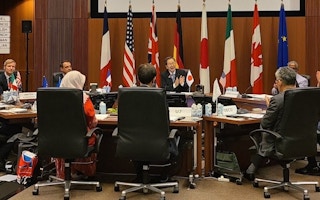In 2022, the G7 leaders declared their intention to open a “climate club” to facilitate international cooperation on limiting global warming to the 1.5°C target as envisioned in the 2015 Paris Agreement. The initiative is still being developed: a full launch of the club is planned for COP28 in November 2023. The G7’s climate club agenda has three broad pillars: advancing climate change mitigation policies; advancing industrial decarbonisation; and boosting international climate cooperation and partnerships.
Some scholars argue that climate clubs are leaner and more effective mechanisms than overarching global climate governance frameworks. However, digging deeper into the literature on climate clubs raises questions and some key concerns about the effectiveness of these initiatives, which has implications for ASEAN.
Climate clubs can be understood as any climate governance initiatives that operate outside of the formal processes of the United Nations Framework Convention on Climate Change (UNFCCC). There are broadly two types of such clubs: “Buchanan” and “Voluntary” climate clubs. The former has stringent membership requirements and all member states must conform to certain environmental standards. In Buchanan climate clubs, there are clear membership benefits such as access to international markets. Buchanan clubs are meant to address the free rider challenge to climate governance, where some countries free-ride, essentially reaping the benefits of climate action by others without bearing a fair share of the costs.
Buchanan climate clubs remain largely theoretical. One study by the Norwegian Institute of International Affairs (NUPI) proposes that the EU’s Carbon Border Adjustment Mechanism (CBAM), which entered into force this year, might be the world’s first Buchanan climate club. CBAM restricts its membership to countries that implement a price on carbon, rewarding its members with greater access to the EU market. Countries that do not implement environmental standards will need to pay a tax to export certain products into the EU.
Voluntary climate clubs are more flexible in the sense that they do not require their members to conform to strict environmental standards. The benefits for members are more diffuse. One example of a voluntary climate club is the C40 Cities initiative, which brings together mayors from around the world to collaborate on urban climate action. From this region, Kuala Lumpur, Jakarta and Ho Chi Minh City are members of the C40 cities group. While the C40 does have a set of Leadership Standards, used to measure performance of members, these standards are broad and overarching. The C40 process is meant to be inclusive and to facilitate the development of best practices. However, such voluntary clubs are often open to the free-riding problem mentioned above, making them less effective as climate governance mechanisms.
It is yet unclear under which category of climate club the G7 initiative will fall. The media release promotes this climate club as one that is “open, cooperative and inclusive” which will seek the participation of all major emitters, including developing countries. Yet this does not explain how the G7’s initiative will mitigate the tricky free-rider challenge. One study by the Center for Climate and Energy Solutions (C2ES, formerly the Pew Center on Global Climate Change), suggests that if the G7 climate club is too exclusive then it will alienate developing countries. On the other hand, if membership requirements are too lax, there will be no progress in global mitigation.
It is likely that as the G7 climate club takes shape, more defined membership requirements around environmental performance may develop. If one of the membership benefits is the provision of access to G7 markets, this may have important economic consequences for ASEAN. Members of the G7 are some of the largest export markets for Indonesia, Thailand, Vietnam, and other regional countries. The risk of losing access to export markets may encourage environmental action at the national level but it can also result in trade disputes such as the recent palm oil conflict between the EU versus Malaysia and Indonesia. Overly stringent membership criteria may inadvertently drive ASEAN governments closer to less-regulated markets such as China, Russia and India, which are unlikely to demand that their trade partners follow similarly rigorous environmental standards.
The G7 climate club is not likely to do much to reduce the gap in cooperation among major powers on climate mitigation. The G7 Leaders’ Communiqué that announced the intention to develop the climate club also condemned Russia’s actions in Ukraine and reiterated financial support to Kyiv. This was an example of how geopolitical conflicts often overshadow climate initiatives. The Ukraine crisis and the tension between China and the U.S. have undermined the COP process; this may well be the case with the G7 climate club. While the climate club is inclusive on paper, conflating climate action with geopolitical issues can discourage the participation of non-G7 major emitters and further alienate the Global South that favours a non-aligned stance.
In addition, the key issue of finance is not addressed by the G7’s proposal, which requires members to aid developing countries on a voluntary basis. For clean energy alone, ASEAN requires annual investments of US$200 -US$245 billion by 2050. Yet, developed countries fell short of providing even what they pledged at the 15th COP, the smaller sum of US$100 billion per year by 2020. For ASEAN, the G7 climate club may well be another forum for rhetorical discussion and declarations, with the same conflicts that have constrained the COP process for decades holding back urgent and concrete action.
Mirza Sadaqat Huda is Lead Researcher in the Climate Change in Southeast Asia Programme, ISEAS - Yusof Ishak Institute.
This article was first published in Fulcrum, ISEAS – Yusof Ishak Institute’s blogsite.









